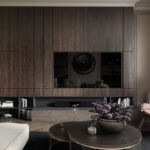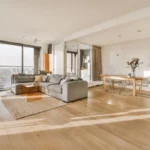Engineered wood flooring is one of the most popular choices for homeowners in Fairfax, VA, and nearby areas, and for good reason. It offers the warmth and look of real wood, along with added stability that holds up to changes in moisture and temperature. But beyond the core benefits, there are countless styles and design details to consider.
At Carpet City & Flooring, we help you narrow it down based on how you live, what you love, and what works best in your space. Here’s a breakdown of the key style elements to understand before you start your project.
Understanding Grain Direction
The direction of the grain in your engineered wood flooring plays a big role in how the floor looks and how it complements the rest of your home. Grain refers to the natural pattern created by the tree’s growth rings, and it varies depending on how the wood is cut.
- Plain-sawn: This is the most common grain orientation. It shows a more traditional, wavy pattern that works well in both casual and formal spaces.
- Rift-sawn: This cut produces long, consistent grain lines that are subtle and clean. It’s often used in modern or minimalist designs.
- Quarter-sawn: Known for tight, linear grain with slight variations, this type adds texture and character without being too bold.
Grain direction can also affect the visual flow of a room. Placing planks parallel to the longest wall or natural light source helps elongate the space and create a cohesive feel.
Color Families: Matching Undertones to Your Home
Wood flooring colors are more complex than just “light” or “dark.” They contain undertones—warm, cool, or neutral—that impact how the floor interacts with your cabinets, walls, and furniture.
- Warm tones: Think golden oak, honey, or amber. These pair well with creamy whites, taupes, or kitchens with rich wood cabinetry.
- Cool tones: These include gray-brown mixes and ash hues that pair best with cooler paint colors, stainless appliances, or black accents.
- Neutral tones: Classic mid-browns or greige floors work with almost any palette, offering flexibility over time.
Lighting also plays a part. Natural light can make cool tones feel softer or bring out the depth in darker stains. Always view samples at different times of day in your actual space before making a final choice.
Shade & Finish: Matte, Satin, or Glossy?
The finish you choose affects not just the appearance of your floor but also how it wears over time.
- Matte finish: Offers a soft, natural look that hides minor scratches and dust. Great for high-traffic households or a more relaxed, rustic feel.
- Satin finish: Strikes a balance between matte and glossy. It adds just enough sheen to reflect light without being too shiny.
- Glossy finish: Offers a polished, formal look but shows dust and wear more easily. Best in low-traffic rooms or spaces where elegance is a top priority.
Choosing the right finish depends on your lifestyle and how much daily activity your floors will see.
Board Thickness & Width
The width and thickness of your planks affect both the feel of the room and the floor’s long-term performance.
- Board width: Wider planks (5″ and up) create an open, modern feel and show more of the wood’s natural character. Narrower boards (under 4″) can feel more traditional and add texture to smaller rooms.
- Thickness: Most engineered wood flooring ranges from 3/8″ to 3/4″ thick. Thicker boards typically come with a thicker top veneer, which allows for more sanding and refinishing down the line, an important consideration for longevity.
At Carpet City & Flooring, we’ll help you choose the right combination of style, width, and construction to match your space and your goals.
Let’s Talk Flooring
Still deciding on the right engineered wood floor? Visit our Fairfax showroom or reach out to speak with a flooring expert. We’ll guide you through samples, finishes, and installation plans that fit your home and your lifestyle.












